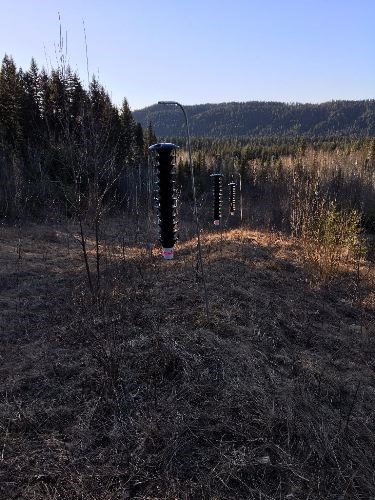Steps have been taken to contain an outbreak of Douglas-fir bark beetle at two popular recreation areas within the city while the weather has also been playing a role.
Clusters of plastic funnel traps have been set up at the Otway Nordic Centre and the Pidherny Recreation area. Developed by now-retired University of Northern British Columbia entomologist Staffan Lindgren, they hold a synthetic pheromone to attract the beetle and a cup at the bottom containing a non-toxic antifreeze to drown them.
But so far flights of the mature bugs to new trees have been in "fits and starts" due to the wet and cold weather so far this spring. That's particularly true at Otway where most slopes are north facing.
"I haven't seen too much action so far," said Jeff Burrows, who's in charge of the effort at Otway.
At Pidherny, about 150 truckloads of infested trees were removed over this past winter while logging has so far been avoided at Otway, where 100-200 trees have been affected.
Packs of anti-pheromone, meant to trick the bugs into thinking a tree is already infested, have been stapled onto about 40 high-priority trees adjacent to the trails at Otway.
"There are some big fir on the ski trails and the bike trail that are over a metre in diameter," Burrows said. "They're really attractive trees and we'd hate to lose them."
At Pidherny, a selection of "trap trees" have also been fallen in places where there have been attacks.The idea is to use them to draw beetles that may have been left over in the stumps of the trees taken out over the winter and dispose of them in the fall.
Dave Banham, a resource manager at Ministry of Forests, Lands and Natural Resource Operations in Prince George, said a further assessment will be carried out this summer and next steps determined from there.
"And that can include everything from burning and disposing of single infested trees right through to going back in with our small scale salvage and doing some harvesting," Banham said.
The outbreak has been attributed to a series of dry summers. The trees consequently lack the water to develop the pitch they need to flush the bugs out. The affected trees show a reddish-brown dust from where the beetles have bored into the inner bark to lay their eggs.
There have been outbreaks in the past but the beetle tends to be less aggressive than the pine and spruce beetles.
"Normally, the fir beetle up here doesn't destroy entire stands," Burrows said. "They just kind of pick away at individual trees and small patches.
"With the wetter summer we had last year and the wet spring and a little bit more cold weather this past winter, I'm hoping the population has been knocked back a bit."



